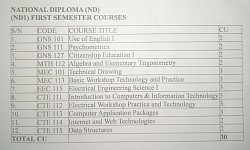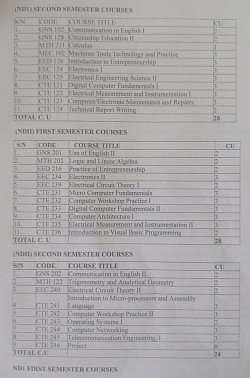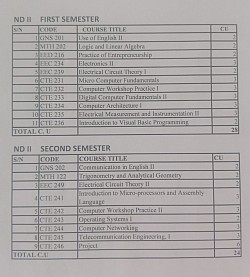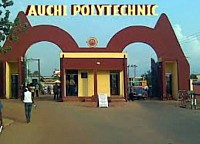Academic Curriculum
ACADEMIC PROGRAMME
The department runs a two years National Diploma (ND) programme in Computer Engineering
Certification and title of the Programme:
The certificate to be awarded and the programme title shall read:" NATIONAL DIPLOMA IN COMPUTER ENGINEERING"
Goals and Objectives
The National Diploma Programme in Computer Engineering Technology is designed to produce Computer technicians to install maintain and repair Computer systems software, hardware and its peripherals. More specifically, diplomats of the programme should be able to:
a) Map out the layout for computers installation and networking;
b) Set up the installations, configuration and the operation of a computer system(s);
c) Set up the installation, configuration and the operation of computer networks;
d) Use appropriate instruments and software to carry out simple tests and measurements on all subsystems in a computer and its peripherals;
e) Carry out routine maintenance and repair:
a. Computer Hardware;
b. Computer Software; and
c. Computer peripherals.
f) Construct simple computer circuit;
g) Develop simple programming codes;
h) Manage a small enterprise.
Entry Requirements
Entry requirements for the National Diploma in Computer Engineering Technology programme include at least a minimum score in the Unifed Tertiary Matriculation Examination (UTME), five credit passes at not more than two sittings in West African Senior School Certificate of Education (WASSCE), Senior School Certificate of Education(SSCE), National Technical Certificate (NTC), General Certificate of Education (GCE), Ordinary level, West African Examination Certificate (WAEC) or National Examination Council (NECO) in relevant subjects. The relevant subjects are: English Language, Mathematics, Physics, Chemistry, and one other subject from: Metal Work, Wood Work, Technical Drawing, Basic Electronics, Basic Electricity, Economics, Commerce, Statistics, Further Mathematics, Computer Studies, Data Processing, Geography and Bìology or Agricultural Science.
Curriculum
The curriculum of the ND programme in Computer Engineering Technology consists of the following four main components:
i. General Studies/Education
ii. Foundation Courses
iii. Professional Courses
iv. Supervised Student Industrial Work Experience Scheme (SIWES)
The General Education components shall include courses in:
* Art and Humanities - English Language, Communication, History
* Social Studies - Citizenship Education, Political Science, Sociology, Philosophy, Geography and Entrepreneurship Studies.
The General Education component shall account for not more than 10- 15% of total contact hours for the programme.
Foundational Courses include courses in
* Mathematics, Pure Science, Technical Drawing, etc. The number if hours will be 10-15% of the total contact hours
Professional Courses are courses that give the student theory and practical skills they needed to practice at the technical level. These may account for 60 - 70% of the contact hours.
Student Industrial Work Experience Scheme (SIWES) shall be taken during the long vacation following the end of the second semester of the first year.
Curriculum Structures:
The structure of the ND programme consists of the four (4) semesters of classroom, laboratory and workshop activities in the Institution and a semester (3-4 months) of student industrial work experience scheme (SIWES). Each semester shall be seventeen (17) weeks of duration made up of ;
* 15 contact works of teaching, i.e recitation, practical exercises, quizzes, test, etc, and
* 2 weeks for examinations and registration.
NOTE: SIWES shall take place at the end of the second semester of the first year.
Synopsis of the Academic & Career Progression ofND holder
He/She
1. Can be admitted into HND programme e.g., Computer Engineering, Electronics and
Telecommunication
2 Can be admitted through direct entry (DE) into bachelor degree programmes
3. Can work as a technician
4. Can manage a small computer-based firms, business centers and other related enterprise(s).
GNS 111 Psychometries
See syllabus for GNS 111
GNS 127 Citizenship Education I
See syllabus for GNS 127
MTH 112 Algebra and Elementary Trigonometry
See syllabus for MTH |12
MEC 101 Technical Drawing
See syllabus for MEC 101
MEC 113 Basic Workshop Technology and Practice
See syllabus for MEC 113
EEC 115 Electrical Engineering Science I
Concept of electric current flow. Simple D.C. Circuits. Various types of energy and their inter-relationship. Concept of electrostatics, electric charge and capacitance of capacitors
CTE 111 Introduction to Computers and Information Technology
History, classification and impact of computers. Concept and management Information Technologies. Fundamentals of computer hardware. Basics, uses and types of computer software. Security and safety procedures within a computer environment. Concept of a computer network. Principles and uses of the internet technologies.
CTE 112 Electrical Workshop Practice and Technology
Applications of wiring and safety regulations. Electrical and clectronic engineering tools and equipment. Construction and uscs of different types of electrical cables and the regulations relating to their uses. Various electrical wiring systems of equipment and accessories and the regulation relating to them. Testing and inspection of clectrical installations.
CTE 113 Computer Application Packages
Existing application packages. Word processing packages, Spread sheets packages. Data base management system (DBMS). Existing statistical packages. Graphics packages. Presentation packages. Concepts in computer aided design.
CTE 114 Internet and Web Technologies
Meaning and historical background of Internet. How to Navigate the lnternet and Common Website Functionalities. Social Media and Various Internet Communication Methods. Online Conferencing and Streaming. Digital Principles, Ethics, Skills and Citizenship. Creation and customizing in HTML. Dynamic Hypertext mark-up language (DHTML). Operation and usage of XML and graphic packages
CTE 115 Data Structures
Concepts of data structure and tools. tools for studying data structure: symbols, relations and graph. Scts relations and string structure. Data life cycle representation, properties of ordered and occupancy. Properties of order and lincar list. Simple linked lists and algorithm complexity. Non-linear structures. Different sorting and scarching technique.
NDI SECOND SEMESTER COURSES
GNS 102 Communication in English I
See syllabus for GNS 102
GNS 128 Citizenship Education II
See syllabus for GNS 128
MTH 211 Calculus
See syllabus for MTH 211
MEC 102 Machines Tools Technology and Practice
See syllabus for MEC102
EED 126 Introduction to Entrepreneurship
See syllabus for EED 126
EEC 124 Electronics I
Concept of thermionic emission. Concept of energy level in materials. Operations, characteristics and applications of semi-conductor devices. Constructional features and configuration of bipolar junction transistors. How the triode and the bipolar transistor can be used as a single stage amplifier. Zener diode and thyristor as switching devices. Constructional features and operation of afield-effect transistor.
EEC 125 Electrical Engineering Science II
Concept of magnetism and magnetic circuits. Concept of electromagnetism and electromagnetic induction. Concept of inductance and its application. Fundamentals of A.C. theory.
CTE 121 Digital Computer Fundamental I
Concept of data and information presentation in digital system. Different codes used in digital system. Fundamentals of Boolean algebra. Various methods of minimization required to simplify digital combinational circuits. Basic digital functions.
CTE 122 Electrical Measurement & Instrumentation I
Various types of indicating instruments. Basic structure of an clectromechanical instrument. Operation and construction of a permanent magnetic-moving coil instrument. Construction and principle of operation of ohmmeter, megger and multimeters. Use of potentiometer for the measurement of clectrical quantities in D.C and A.C circuits. Theory of errors in measurement and its applications. Construction, principles of operation and use of cathode ray oscilloscope (CRO).
CTE 123 Computer/Electronic Maintenance and Repairs
General use of tools and testing instruments. Cabling, jointing soldering and de-soldering techniques. Diferent electronic circuit components. Use manufactures service manual and circuit wiring diagrams. Maintain gsm phones. Use of uninterruptible power supply (UPS) and automatic voltage regulators (AVR).
CTE 124 Technical Report Writing
Concept of proposal writing. Content of a technical report. Information that is required in technical report writing.
NDII FIRST SEMESTER COURSES
GNS 201 Use of English II
See syllabus for GNS 201
MTH 202 Logic and Linear Algebra
See syllabus for MTH 202
EED 216 Practice of Entrepreneurship
Sce syllabus for EDD 216
EEC 234 Electronics II
Operation of signal amplifiers, General principles of feedback and oscillators. Principles of switching circuits. Basic clectronic logic gates. Basic circuits used in power supplics.
EEC 239 Electrical Circuit Theory I
Goal: This course is designed to provide students with basic knowlcdge in electric circuit Kirchhoff's laws and their application in solving d.c electrical problems. A.c theory and apply it to the solution of simple electrical circuit. Mesh and Nodal analyses and their applications in solving clectrical problems. Network transformation and Duality principles. Network theorems and their applications D.C and A.C circuits.
CTE 231 Microcomputer Fundamentals
Processor and the component parts. Memory and storage devices of computers. Operations of input devices in computer system. Operations ofoutput devices in computer system. Concepts and function of power supply in computer system. Serial and parallel communication and devices in computer. Multi-user environment. Different types of modems and their uses.
CTE 232 Computer Workshop Practice I
Various components of the computer system. Perform computer installation using manuals. Preventive and maintenance of computer systcm. Assemble and install a computer system.
CTE 233 Digital Computer Fundamental II
Features of different logic gates and the sequence and data flow controls. Basic principle of bistable elements and the principle of counter and register. Implementation of the addition operation in the computer and digital circuit componcnts. Characteristic of basic digital devices and the design and construction of simple combinational logic circuits using the basic Devices. Operation of bistable elements and simple sequential circuit.
CTE 234 Computer Architecture I
Basic concept of computer architecture. Concept of memory organization of computer system. Appreciate the conventional 8/16/32/64 -bit computer architecture. Addressing modes. Interrupts and their various types.
CTE 235 Electrical Measurement & Instrumentation II
Types of meters for measuring power and power factor. Types of bridges (A.C. And D.C.). Principle of operation of a fluxmeter and its application. Principle and use of digital instruments. Factors which should be considered when sclecting an instrument. Main typcs of measurements and measuring instruments.
CTE 236 Introduction to Visual Basic Programming Language
Integrated development environment. Visual basic programming concept. Control statement in OOP. Usage of procedure and functions. Use of arrays and structures. How to create classes and functions. How to create classes and objects. How to create and manipulate data files. Dialogue box concepts.
ND11 SECOND SEMESTER COURSES
GNS 202 Communication in English II
See syllabus for GNS 202
MTH 122 Trigonometry and Analytical Geometry
See syllabus for MTH 122
EEC 249 Electrical Circuit Theory II
Prnnciples of power calculation in A.C. Circuits. Simple integrated circuit (IC) and its ratings. Time domain analysis of RC, RL and RLC circuits. Magnetic coupling phenomena.
CTE 241 Introduction to Microprocessors & Assembly Language
Concepts of microprogramming and Microprocessors. Basic terms in assembly language. Different instruction formats. Representative groups of instruction in the instruction set. Process of running assembly language programs.
CTE 242 Computer Workshop Practice II
Circuit diagrams of monitors, UPS Power Packs etc. Principles of operation and use of basic electronic measuring instruments in trouble shooting. Diagnostic techniques involved in corrective maintenance. Trace faults on the various components of the circuits using a modular approach.
CTE 243 Operating Systems I
Concepts of an operating system. Classification and diflerent types of operating system. Functions, characteristics, and components of operating system. Services, properties, and structure of an operating system. Gneral concept of system programming. Use of utilities and libraries
CTE 244 Computer Networking
Basic concepts of computer networking. Hardware components of computer networks and their functions. Network planning and design. Types of network connections. Internet works today, applications of theory in current technology and wireless network access. Open system interconnection (OSI) model and the TCP/AP model and networks using IPV4 and IPV6. Construct and debug a small-medium IP network.
CTE 245 Telecommunication Engineering I
Basic principles of telecommunication systems. Principles ofoperation and application various transducers. Basic principles of modulation and demodulation. Principles of amplitude modulation and frequency modulation. Principle of the radio receivers. Principles of black and white television transmission. Various frequency bands within the radio spectrum. Principles of electromagnetic wave radiation. Principles of radio wave propagation. Characteristics of simple telecommunication circuits.




